Victron Phoenix Smart IP43 Charger, charging perfection?
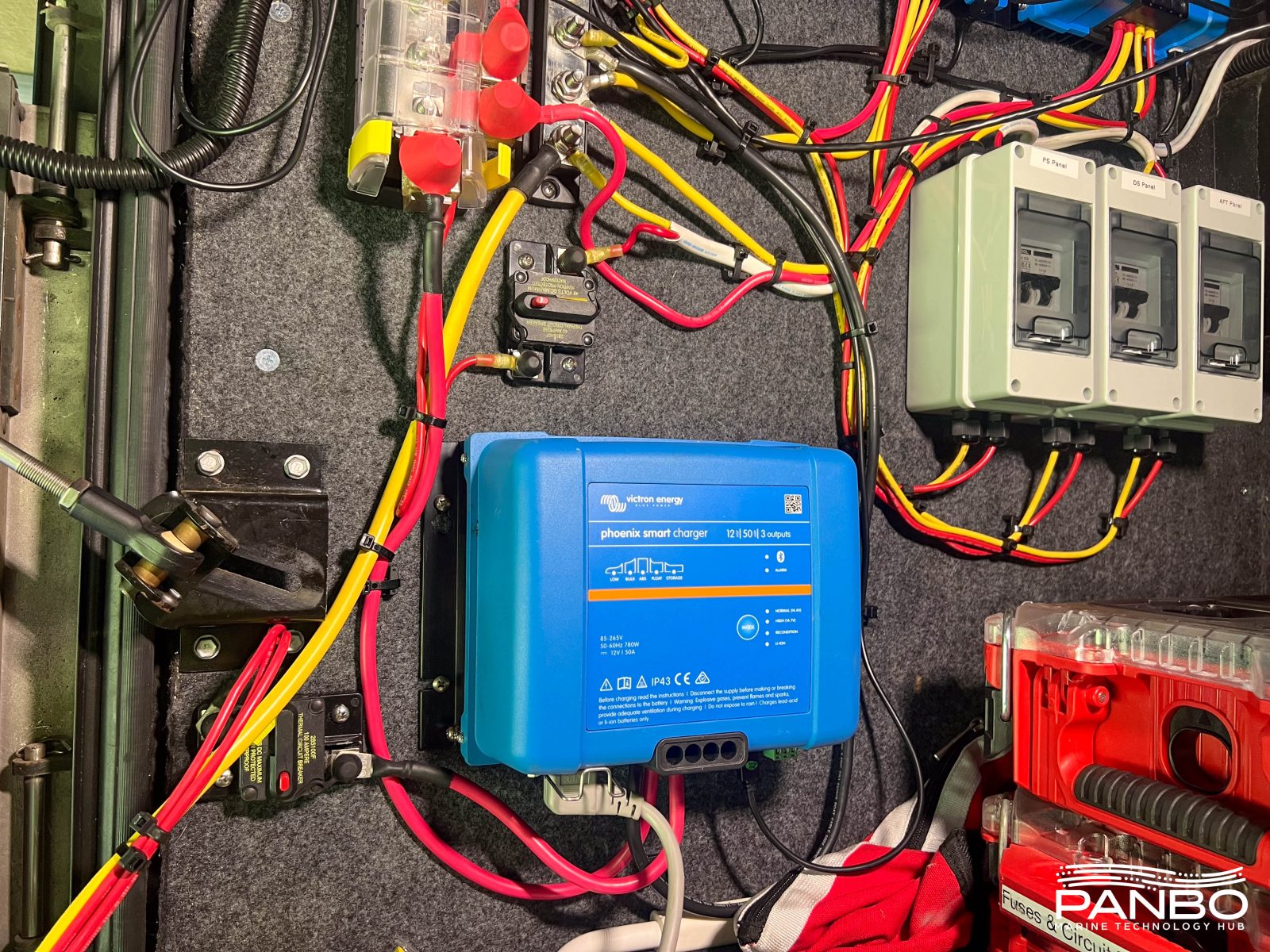
I’ve written a lot about Victron’s products. In fact, I’ve written enough that I sometimes fear my readers will see another Victron article and roll their eyes. But, yet again, I find myself with a compelling Victron product that I think you should hear about. This time, it’s a battery charger. I realize you may not think of battery chargers as the most exciting piece of technology on your boat, but bear with me and read on to hear why you should be excited by this one.
The Phoenix Smart IP43 line is available in 30 or 50-amp 12-volt varieties and 16 or 25-amp 24-volt models. The higher amperage option in each voltage sells for $530 while the lower amperage model sells for around $420. The chargers are available in 3 output models with the total output divided among up to three connected batteries or in what Victron calls 1+1 models. The 1+1 models output up to the full rated capacity to a single output and can also output up to 4 amps to a second battery. The second output is primarily designed to maintain a start battery.
Both the 1+1 output and three output chargers feature FET-based isolation of the outputs. The FETs ensure no current transfer between the connected banks. The three output chargers can output rated output to any one of the banks or split it across them. All charger models support a single chemistry, so you can’t mix and match battery types among the outputs. Additionally, all outputs operate in the same charge stage, bulk, absorption, float, or storage.
What’s so special about this charger?
I’ve spoken pretty highly about this charger. So, you might be wondering what this charger does so differently than other chargers on the market and the ones you already have on your boat. The difference in a nutshell comes down to three main attributes, small size, extensive connectivity, and configurability.
Connectivity
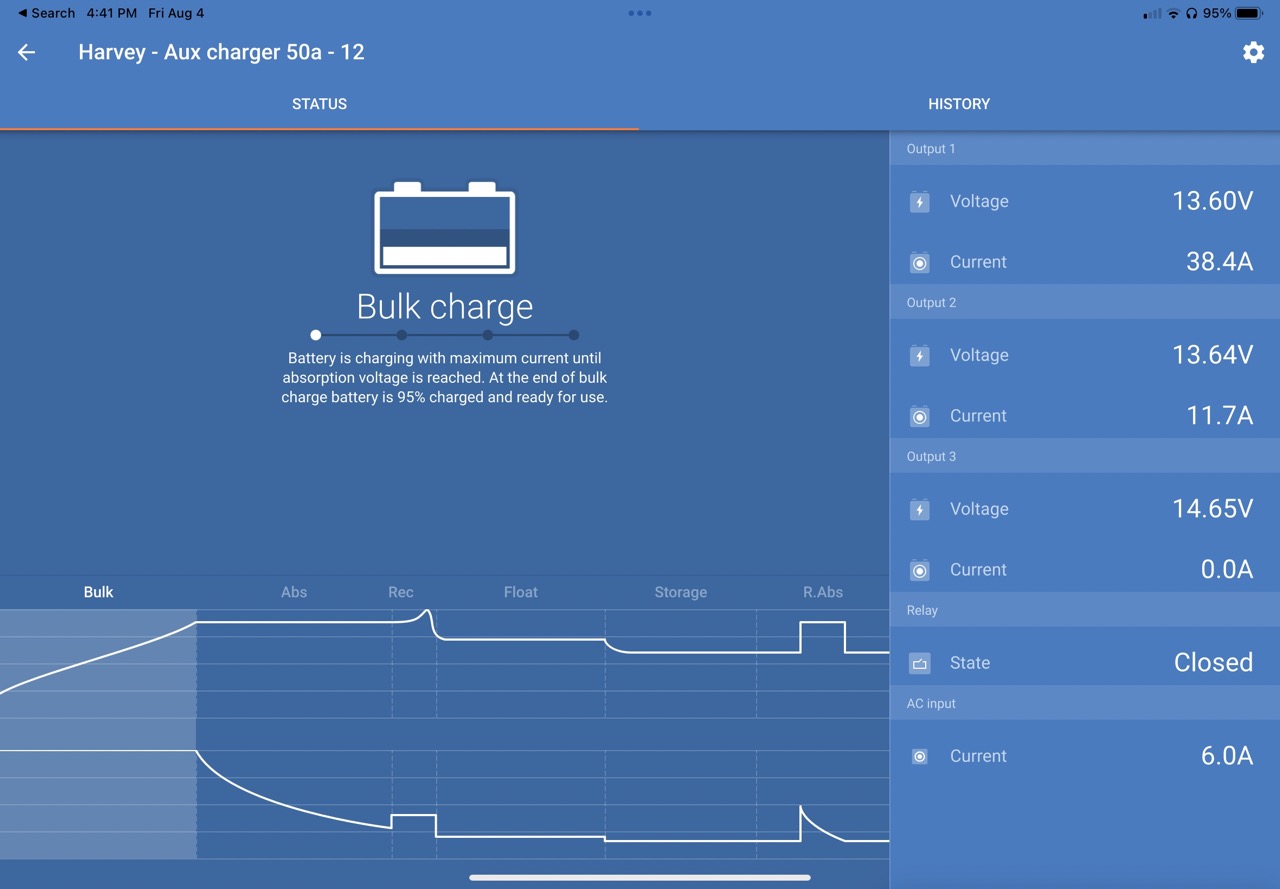
The IP43 chargers have a built-in Bluetooth interface that allows connectivity with Victron’s BMV-712 battery monitor and Smart Battery Sense as well as the Victron Connect app. In addition to Bluetooth, the IP43 charger has a VE.Direct port. VE.Direct is Victron’s proprietary serial connection that allows simple devices like battery monitors, solar controllers, and chargers to communicate with GX devices running Victron’s Venus OS.
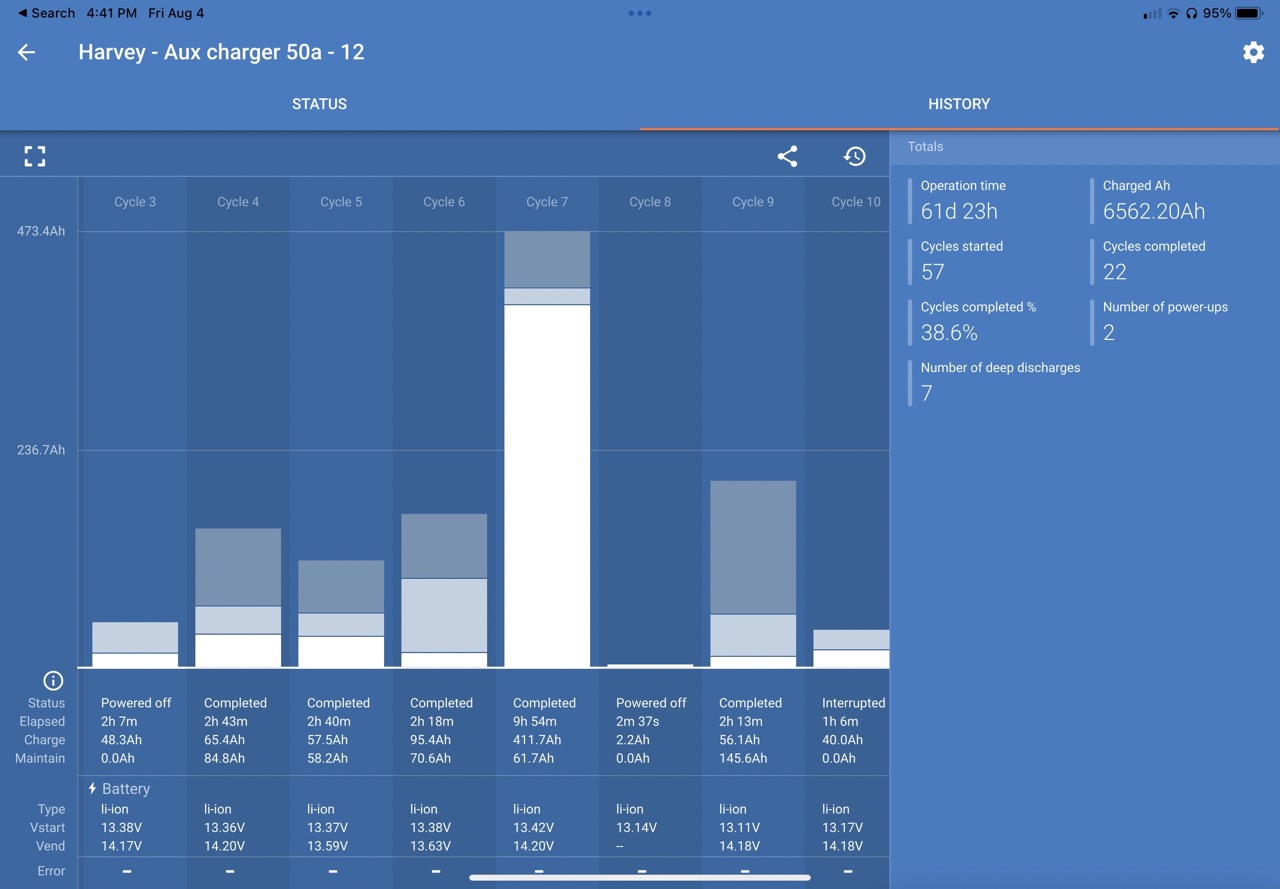
VictronConnect provides extensive insight into the charger’s current status and historical operations. Lifetime totals for the charger help you understand longer-range trends including how often charge cycles are completed. I’ve been testing a lot with this charger and hence interrupted it much more often than I think would be normal.
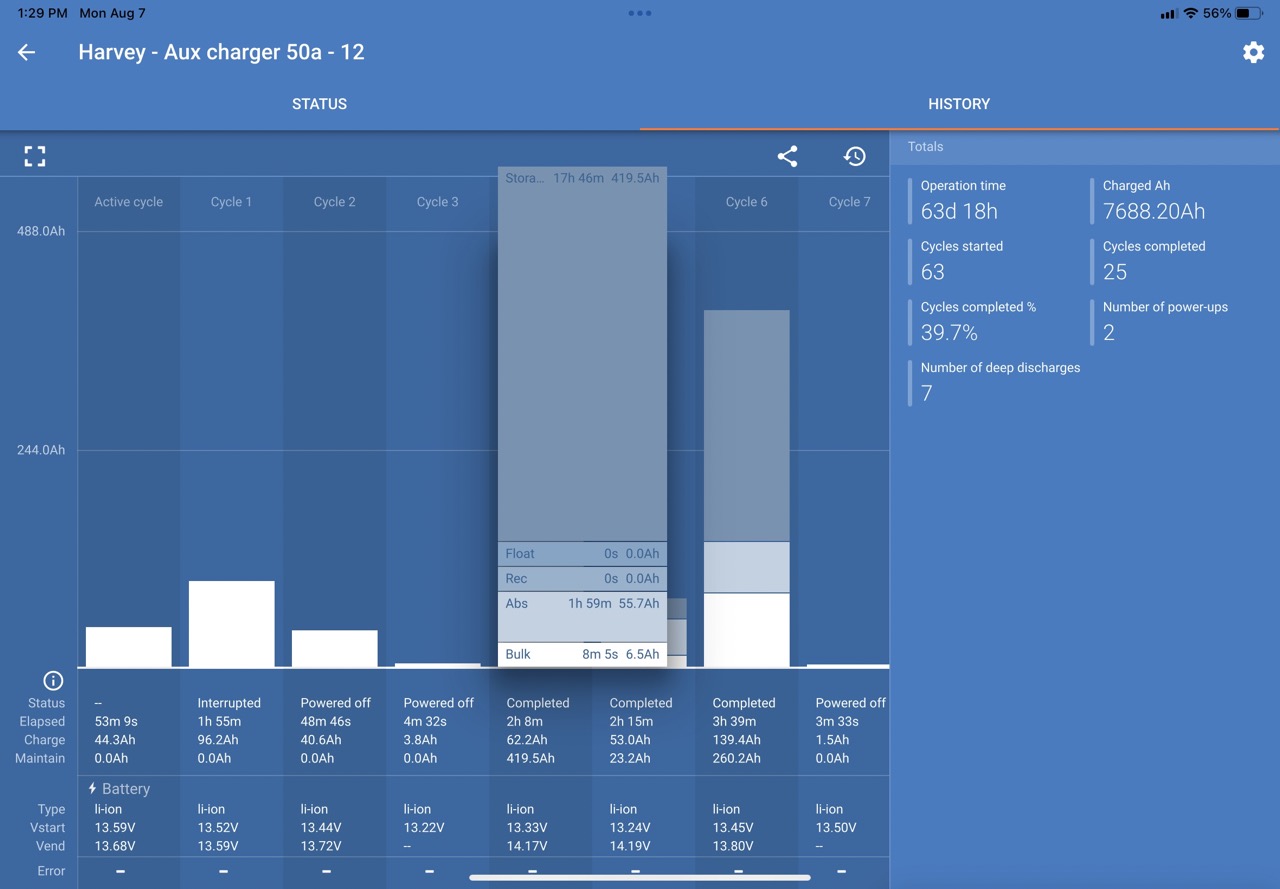
Each charging session is logged with full details of the charge cycle. I particularly like the detailed breakdown of each cycle and how long the charger spent in each stage.
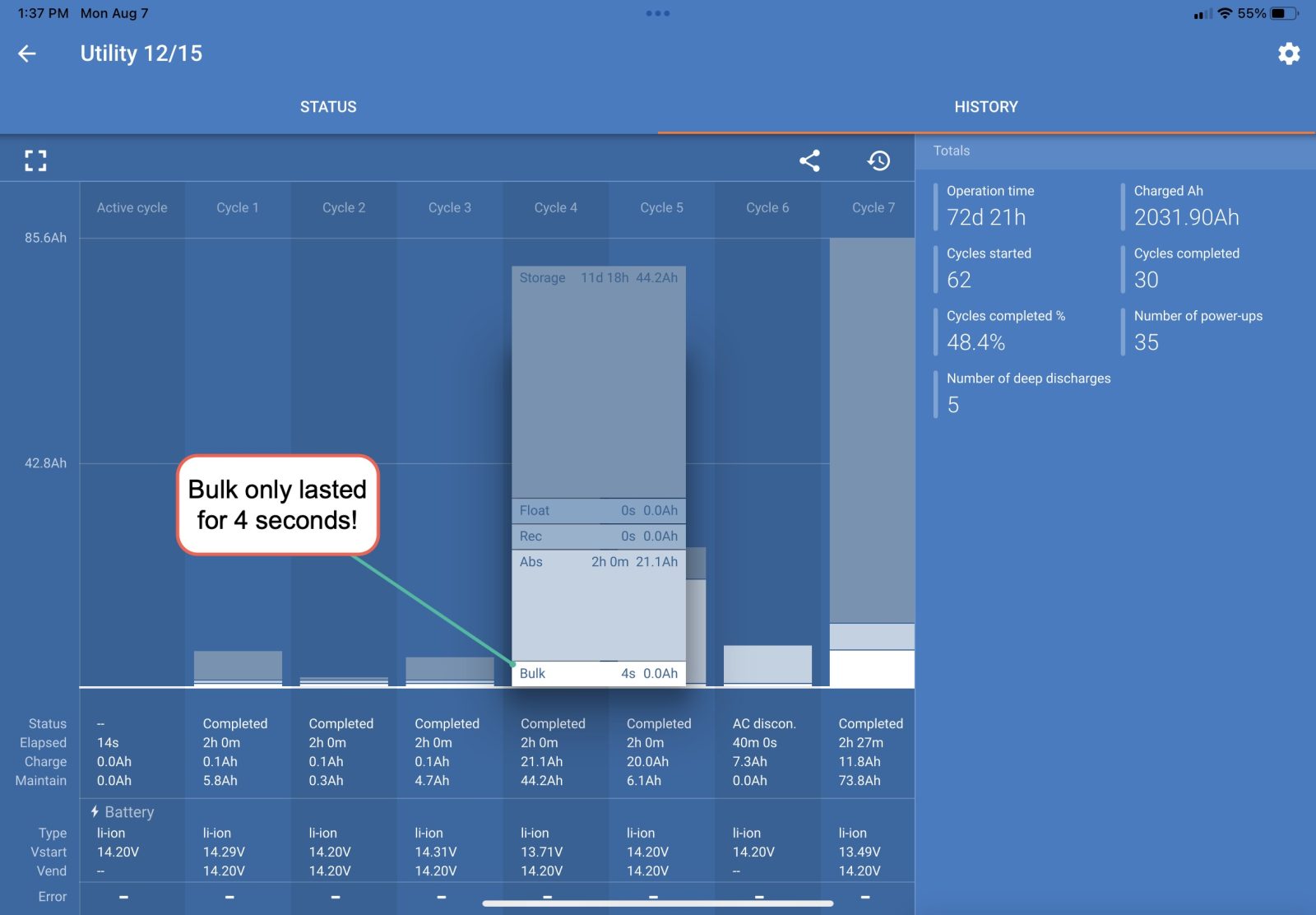
In fact, the cycle history has proved very useful to identify a wiring issue on a little brother to the Phoenix Smart IP43. I use BlueSmart IP65 chargers for quite a few utility charging needs. Looking at cycle histories on a 15-amp model, I noticed the bulk phase was only lasting a few seconds. It turned out the quick connect fitting I was using on a battery created a high resistance connection impeding charge speed and producing heat. I found it because the charger was quickly exiting bulk since the high-resistance connection caused the charge current to drop below the charger’s full 15-amp output.
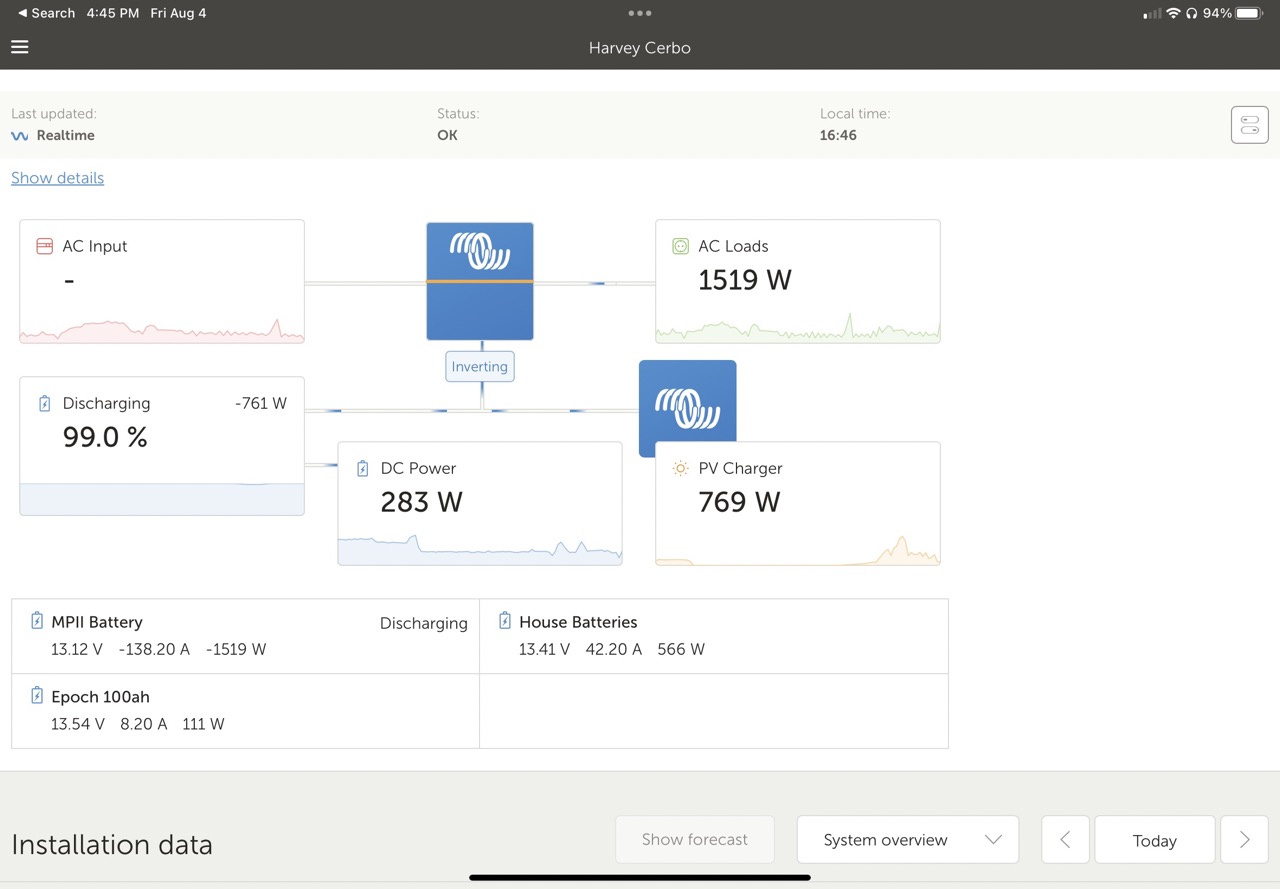
Additionally, if the Phoenix IP43’s VE.Direct port is connected to a Victron GX device running Venus OS, output measurements can be displayed under the system visualization. In the screenshot above, the “House Batteries” and “Epoch 100ah” measurements represent the battery 1 and 2 outputs of the charger.
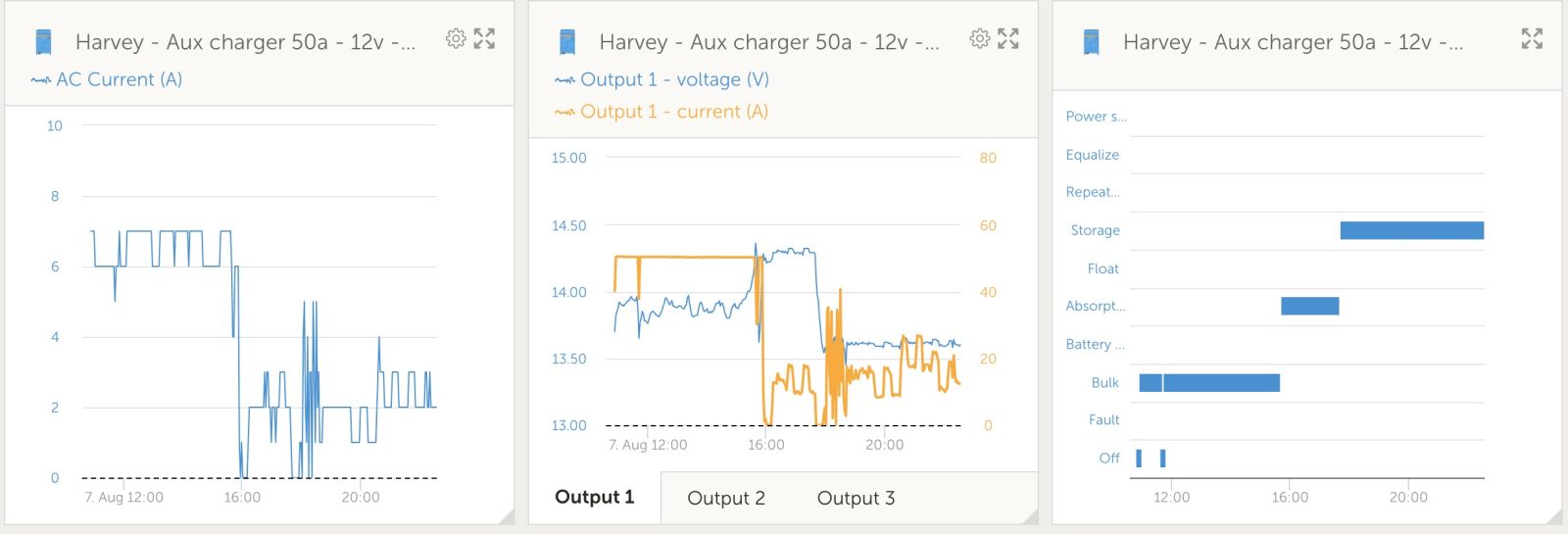
VRM’s advanced widgets can also show further detail about the charger’s operational history. Compared to most chargers, this is an embarrassment of historical data riches. For example, Have Another Day had multiple older Phoenix chargers onboard. But, these chargers are equipped with a single ammeter so there’s no visibility into how much current is going to each output, just a total number. That single analog ammeter made determining the charge rate of a single battery bank difficult. In contrast, this level of detail makes that task trivial.
Configurability and control
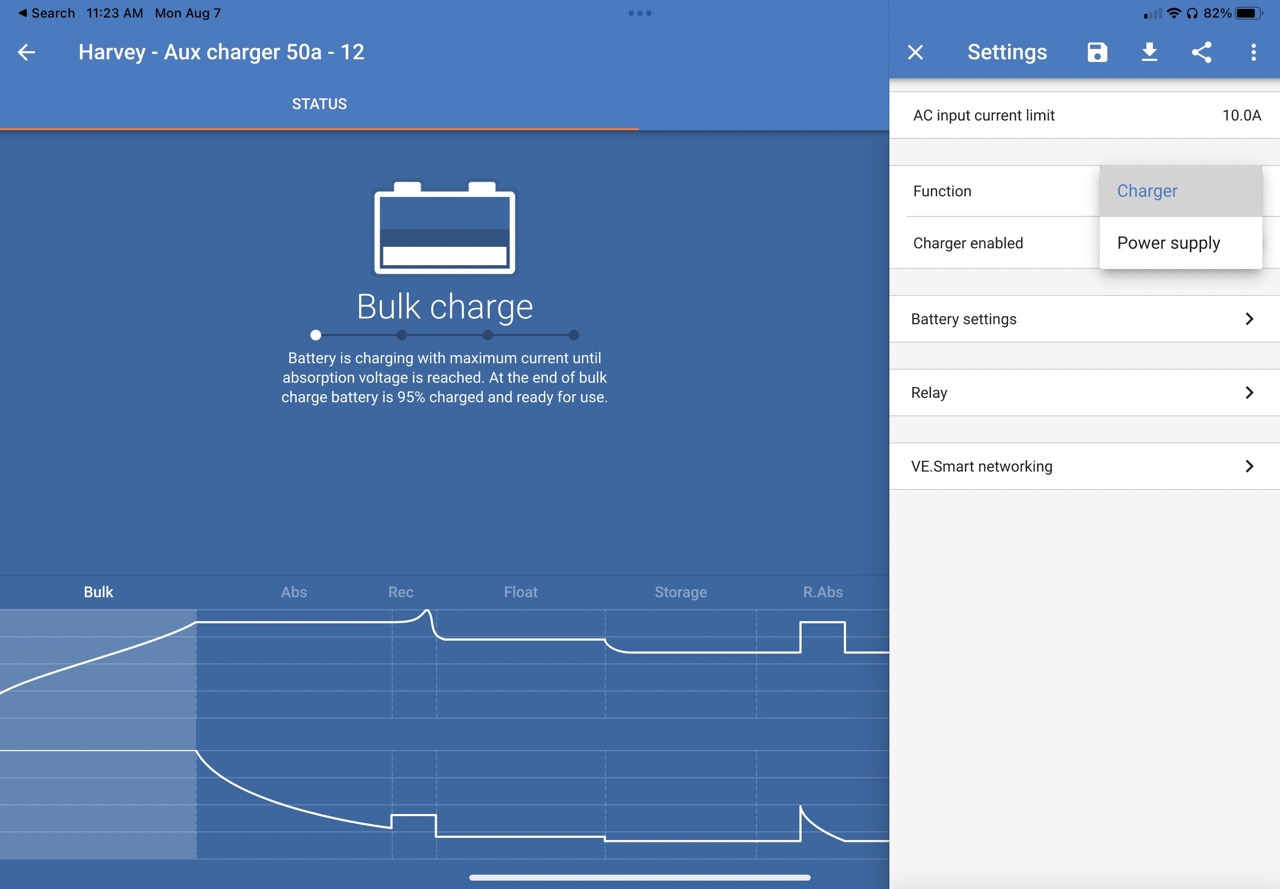
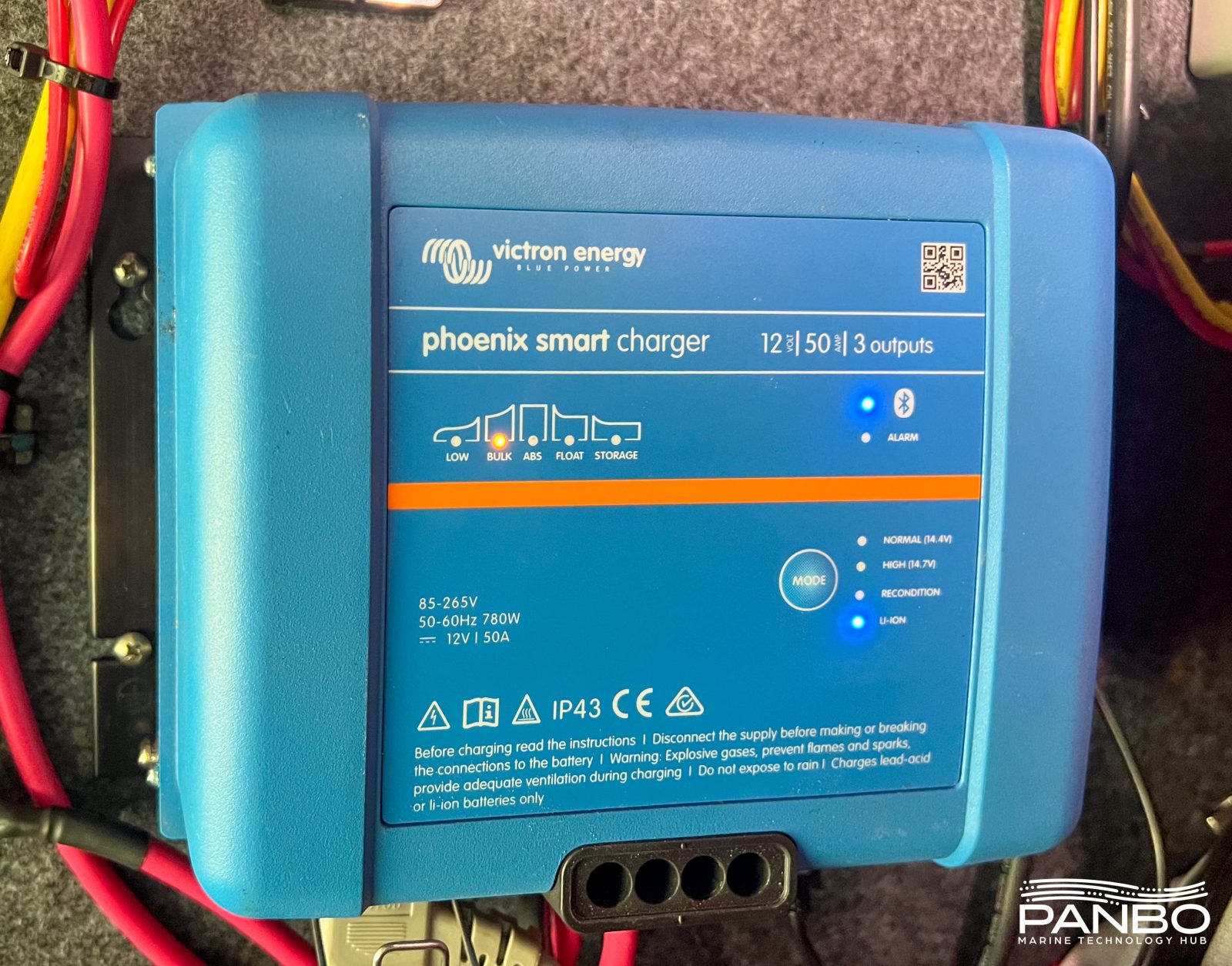
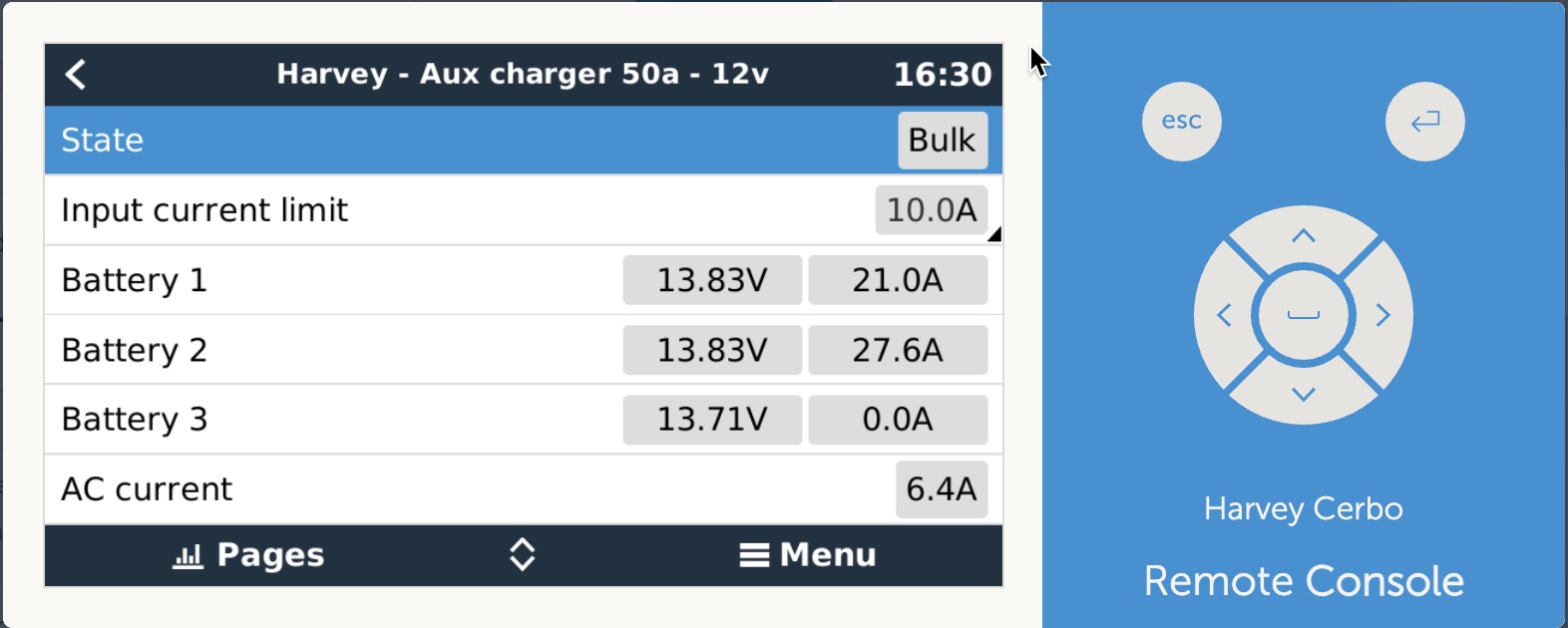
The Phoenix IP43’s connectivity options make configuring the charger very easy. The simplest method is via the VictronConnect app on a mobile device. The app connects to the charger via Bluetooth and offers fine-grained control of nearly every aspect of the charger’s operation. Additionally, as is shown in the last, Remote Console screenshot above, the charger’s current limit and on/off switch can be controlled via a GX device’s console.
Mode button

I’ll get into the more advanced configuration options in a moment, but first I want to point out the ease of using the charger right out of the box. There’s a mode button on the right side of the charger that cycles between Normal, Normal + recondition, High, High+ recondition, and Li-ion presets.
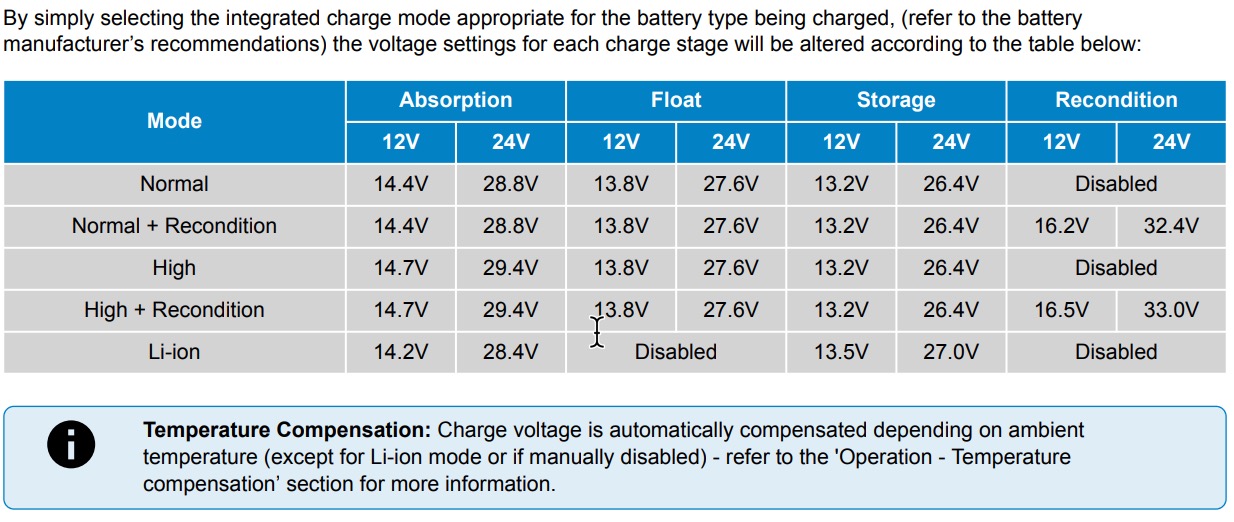
The first four presets are intended to be used with various lead-acid chemistries and designs, either with a reconditioning or equalizing cycle or without. The last is appropriate for most LiFePO4 batteries. It sure is easy to quickly top up a battery by simply tapping the mode button until the proper mode is selected.
Victron Connect
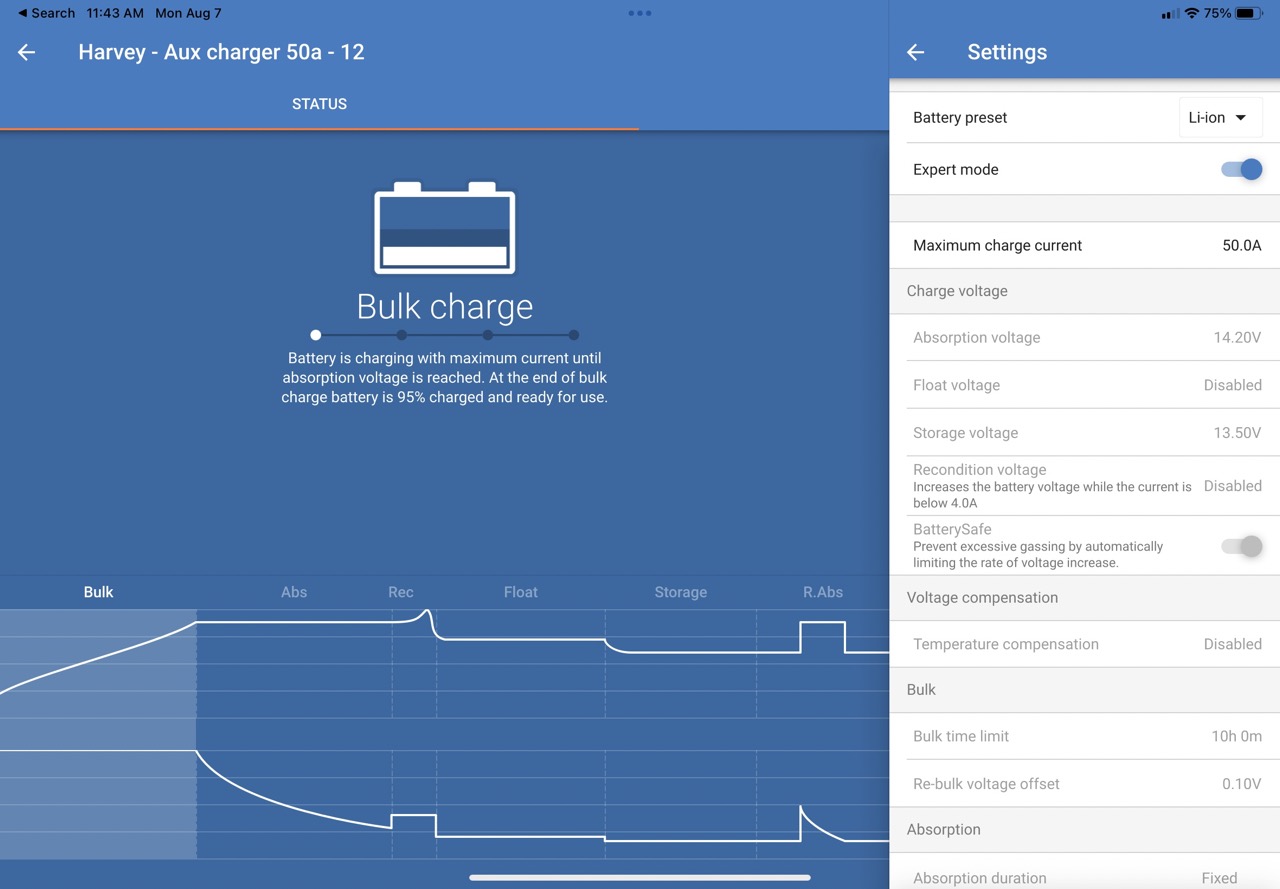
VictronConnect, Victron’s Bluetooth configuration program, is available for Android, iOS, Linux, MacOS, and Windows. In addition to the status monitoring and history functions mentioned above, the app allows the selection of several presets or the configuration of user-defined presets.
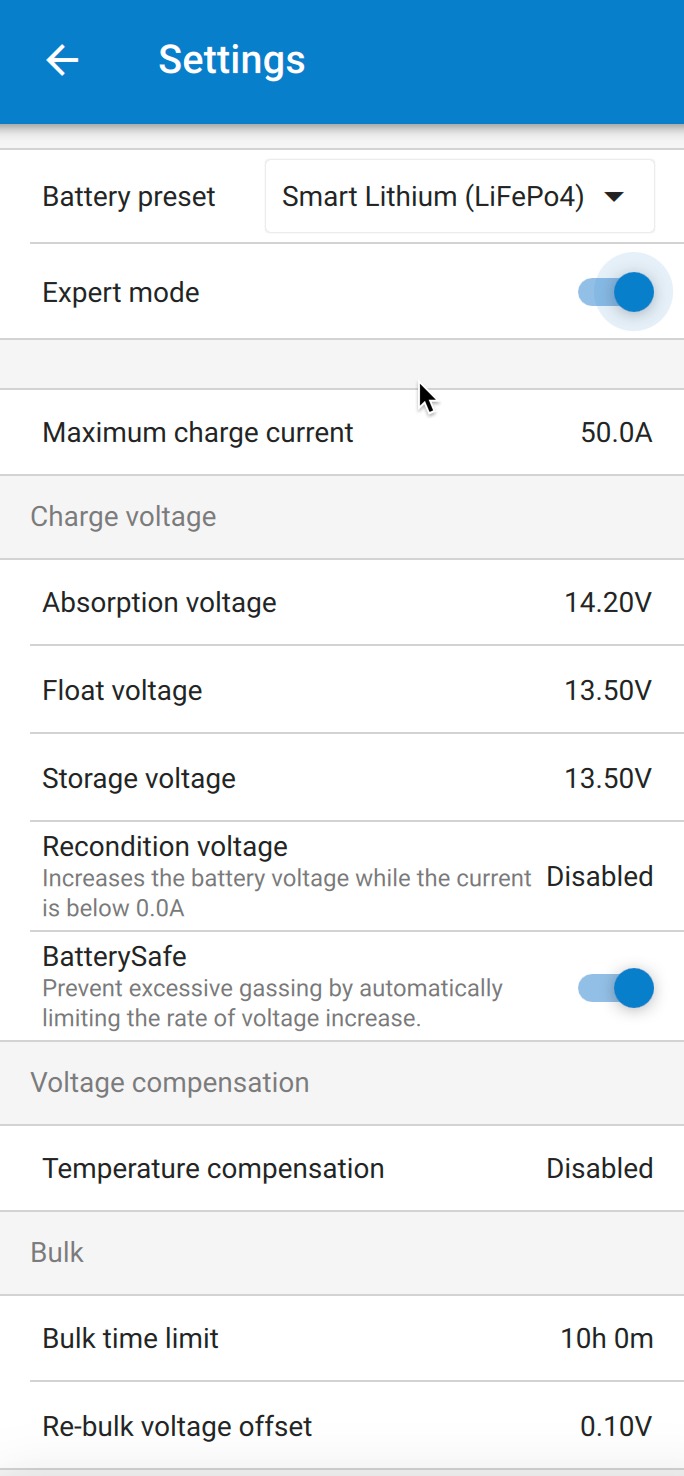

Advanced battery settings
As you can see in the settings screens above, nearly every aspect of the charger’s operation can be controlled. Given the varying recommendations from chemistry to chemistry and manufacturer to manufacturer, it’s very helpful to have such granular control.
GX Console
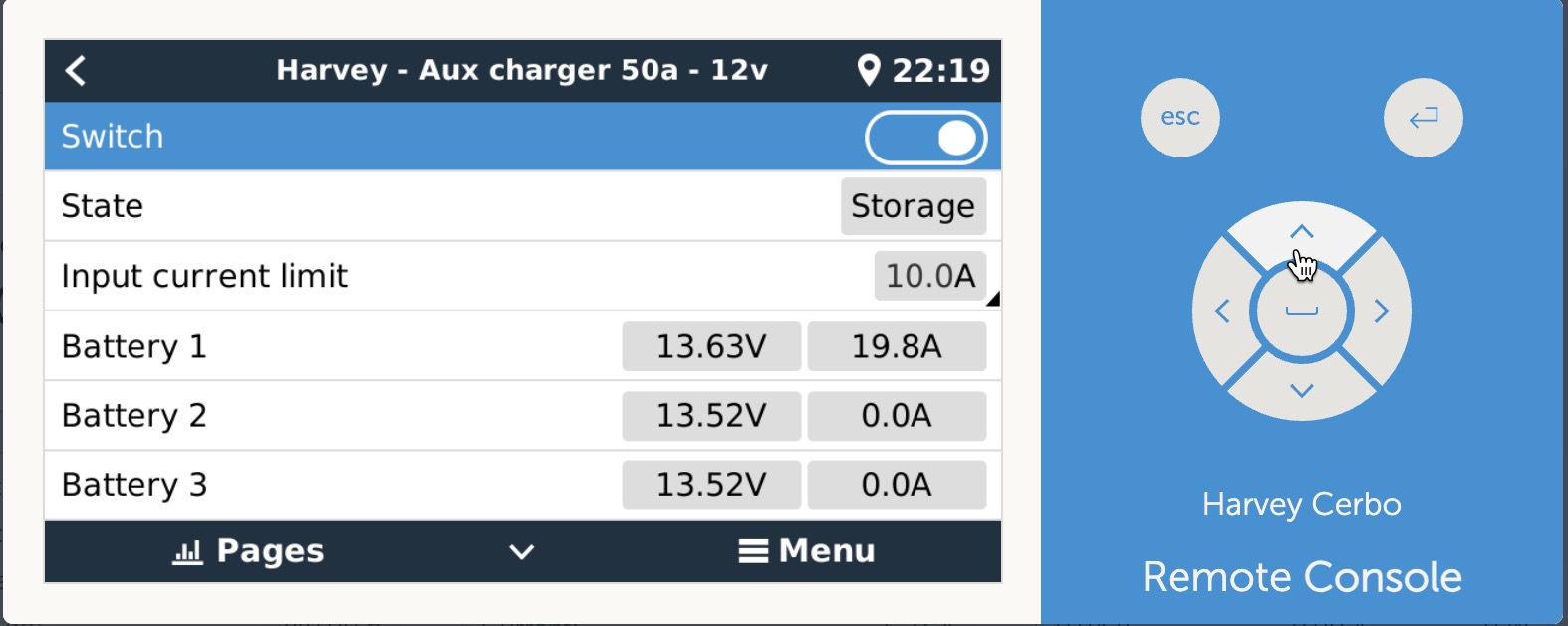
The last means of controlling the charger is via a GX device’s console. Either locally via a display connected to the GX device or via VRM’s remote console. The screenshot taken above shows the remote console. Via the console, you can enable or disable charging or set an input current limit. The lowest allowable input limit is 3 amps at 120 volts AC.
Small size
At 6 pounds and 7.1 by 9.8 by 4.6 inches for all models, these chargers are dramatically smaller than any other similar-capacity chargers in the Victron line. For example, the 50-amp, 12-volt Phoenix charger weighs 8 pounds and is 13.8 by 7.9 by 4.3 inches. By comparison, that means the IP43 occupies 320 cubic inches whereas the Phoenix occupies 469 cubic inches. For further comparison, a ProMariner ProNautic 1250P charger is 7.75 pounds and 10.5 by 6 by 14.8 inches or 932 cubic inches.
Real-world use
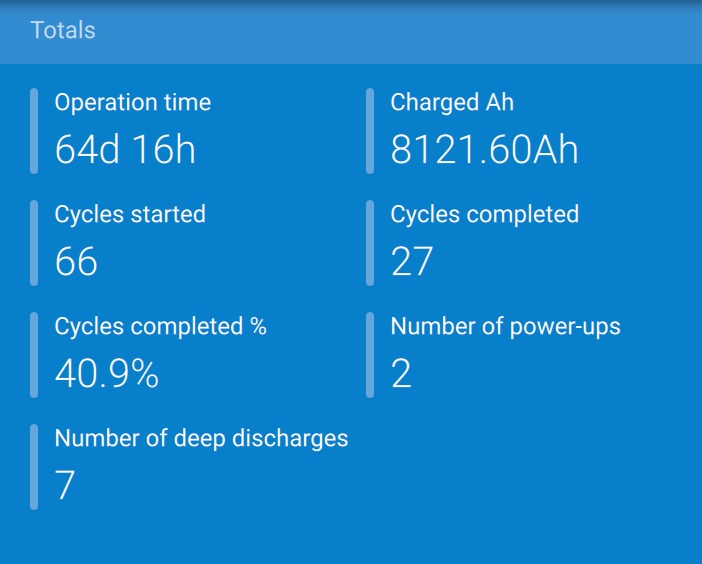
I’ve put the Phoenix Smart IP43 into service in a couple of capacities during my testing. Currently, it’s mounted in Harvey, my RV, topping off the house batteries when I need a little more charge or when shore power availability is limited. Previously, it’s come in very handy on my test bench. During capacity rundown tests, I’ve been able to remotely turn the charger on as soon as the test battery has reached 0% SOC. It’s a real luxury to be able to turn on charging remotely and not leave the battery at 0% SOC where LiFePO4 batteries don’t like to dwell.
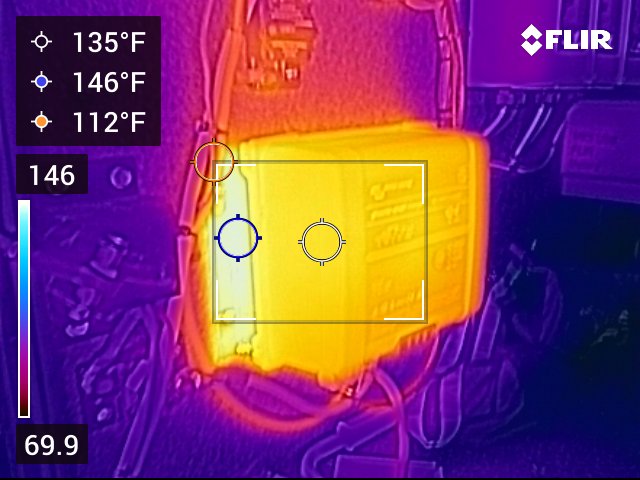
So far, the charger has been reliable, easy to use, and trouble-free. In light of the small form factor and no active cooling, I’ve been watching temperatures on the unit and although it definitely gets hot, it’s been ok so far. The measurements above were taken after running the charger at maximum output for several hours.
BlueSmart Chargers
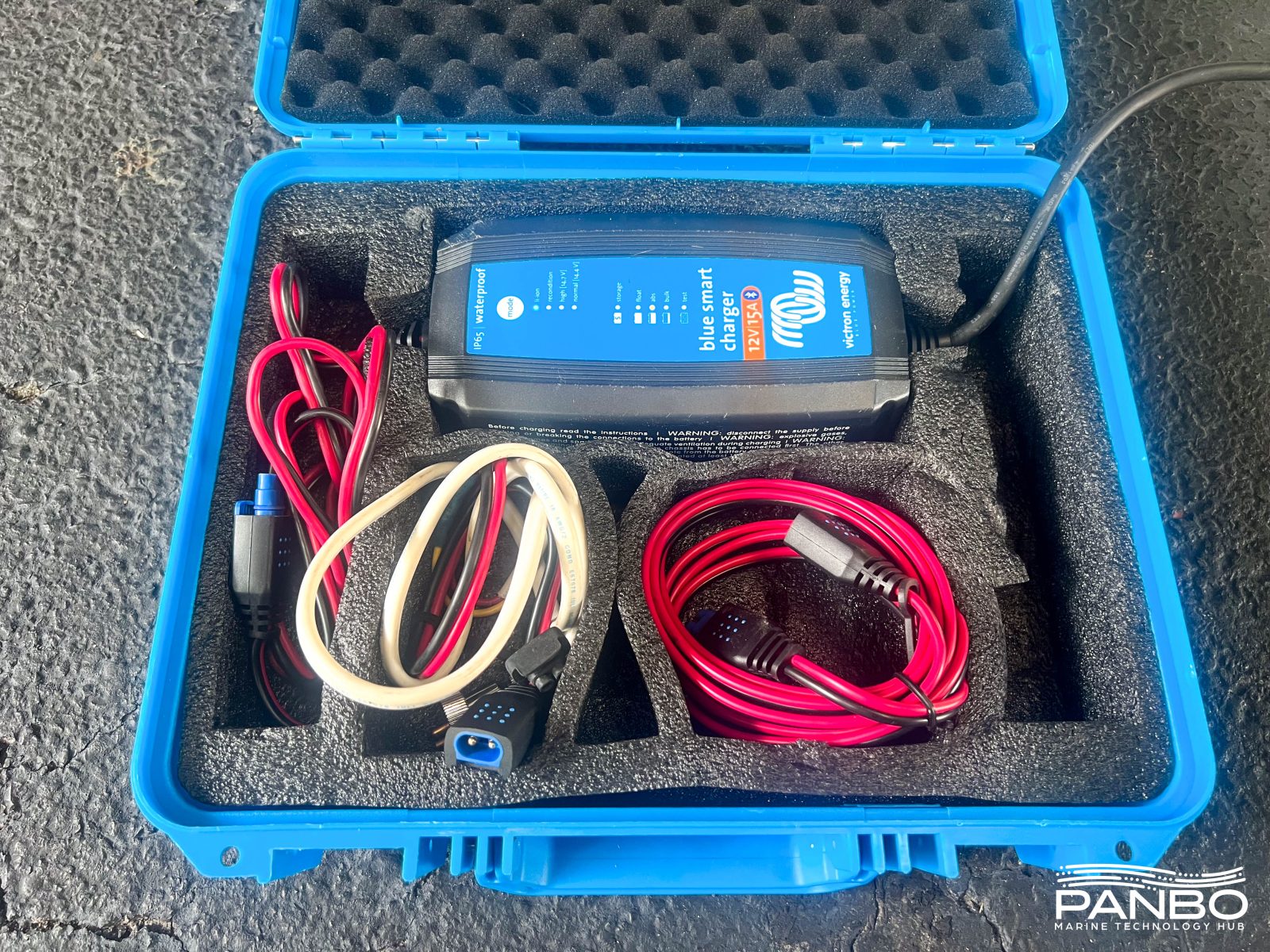
In addition to the multibank, fixed mount Phoenix Charger, Victron also offers a similar, portable charger, the BlueSmart IP65 charger. The charger is available in 6, 12, and 24-volt configurations with outputs ranging from 1.1 to 25 amps. It is equipped with most of the features I’ve mentioned for the Phoenix with the exception of a VE.Direct interface. So, it won’t integrate with a GX monitoring system, but given its portable nature, that’s likely fine. Rodd Collins of MarineHowTo.com has written up the BlueSmart in detail and professes a great affinity for the charger.
Final thoughts
Is this charging perfection? That’s probably a little bit strong. I think I’ll reserve that description for a charger capable of multiple chemistries and stages on its outputs. But, this is one hell of a charger. With detailed control and reporting, I find myself with very little about which to complain and a lot to appreciate. At similar costs to other, less communicative chargers, this is an extremely compelling option.



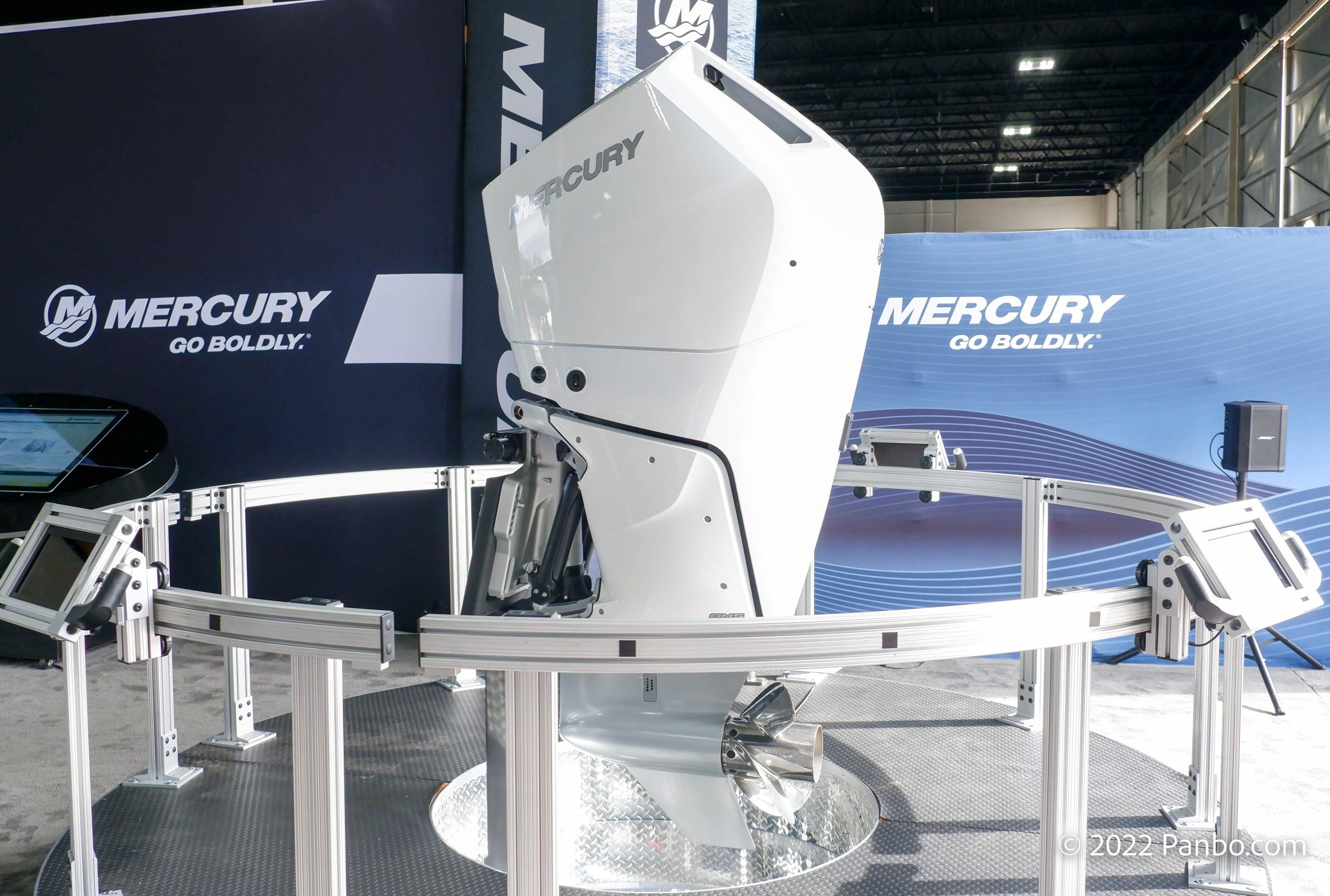










We like these chargers a lot. Now if we can only get 24V x 100A versions, to replace the old Skylla-i’s….;-)
The interface is certainly a very positive feature. But I have to say that the Blue Sea Systems P12 40A charger I have had for six years now seems a much more capable product as a charger. It will handle three batteries and allow the user to set the chemistry and customize the various charging voltages foe each battery separately. It also has temperature compensation and a battery temperature sensor and an adjustable rather quiet cooling fan. The drawback is that the settings have to be done on the unit itself with the control buttons. Mine is in the engine compartment and somewhat hard to reach and read the display. They do have a remote panel for it but I don’t really have a good place to mount it.
So while this is an interesting product, most of the functionality (except for the interface) has been available for quite a few years.
The P12 is a really nice charger with a ton of features packed into it. But, I wasn’t aware it supported multiple chemistries. I just spent a while going through the manual (https://d2pyqm2yd3fw2i.cloudfront.net/files/resources/instructions/980025140.pdf) and it doesn’t describe any way to set chemistries on individual outputs. Also, it talks about batteries entering pre-float when absorption has completed and then moving to float when all three banks exit absorption. Pre-float seems to be a fixed 0.5v lower than absorption voltage. That seems to imply a single stage for the whole charger. But, I don’t have one on hand to dig deeper. Can you double-check how multiple chemistries are enabled?
-Ben S.
I think you are correct and I was mistaken. I had looked into this a bit a few years ago when I was thinking of changing my house bank. I thought that if you selected “User” as the battery type, the charging voltages could be adjusted to custom values for each connected bank.
As for the single stage of operation, I am pretty sure that I have noticed different charging voltages on the display for the three banks. I will check again next time I am on the boat. It may be that just the amperage is different, Anyway, I have had good experience with the P12. My four (two on house in parallel) Lifeline Group 31 AGM batteries seem to be enjoying a long and happy life entering their seventh year of being maintained by the P12 and the staring batteries can crank over my Cummins QSB Diesels easily.
The P12 is a great charger and I’m glad you shared your experience with it. I think it’s a pretty compelling option if you don’t already have an investment in Victron equipment. The onboard display makes a lot of information available at a glance.
To me, the holy grail remains a multi-chemistry charger with all the features we’ve discussed, but those are elusive.
-Ben S.
TBS Electronics from the Netherlands produces a charger where you can set individual chemistry per output.
https://tbs-electronics.com/product/omnicharge-battery-chargers-20a-60a-12v-24v/
Maybe with the wider penetration of non-lead acid batteries, the charger manufacturers will see there is a market for a product that can handle a mixed system. Then again, maybe they just want everyone to buy two chargers.
I’m the new Marine Product Manager for Xantrex – I know this article is based on a smaller amperage charger, but Xantrex has the 120A-12V 6 bank Xplore charger that can support dual chemistries. It is designed for working with both house (2) and engine bank (4) . Have you looked into that unit? I would be glad to hear your feedback.
Jason, the Xplore charger looks impressive, but the documentation is incomplete. I downloaded the manual, and there’s no detail on how to configure individual outputs for chemistry, charge limit, bank size, or anything else – and some of the page references within the document are in error. Is there a separate document that describes this?
Without accurate documentation it’s hard to assess it’s true capability…
Hi Ben, another nice review, big fan of Victron’s components as well – but, I’m not sure what value multiple charge outputs are, if they are all locked into the same profile. Even if they don’t support different chemistries, is it too much to ask that they at least INDEPENDENTLY sense and transition among Bulk/Absorption/Float phases? If my house bank is 50% SOC, and the start battery is 98%, do I really want the start bank to sit in absorption for 4+ hours? No, I don’t. At least the P12 has the “pre-float” feature in an attempt to address this. I have the 25A version and the remote clearly shows (albeit with a % bar graph) the batteries entering the pre-float stage independent of one another. The integration with BlueSea’s ACR’s to isloate the banks when the charger is active solves another tricky issue when an ACR is part of the system, another reason I chose the P12.
We have to of the 50A versions and boy do the get hot!
Perfect timing for this review as I’m trying to decide between the IP43 and the Blue Smart IP22. The latter has a fan for cooling and is ~$200 vs. $400 for the IP43 though that’s not enough of a difference to choose one vs. the other. The IP22 seems to have all the same integration with other systems (I’ll be adding 4 MPPT and already have a smart shunt). I’ll just be charging he house with a DC to DC to sort the starter.
Rob,
I don’t think any of the BlueSmart chargers have VE.Direct interfaces. That means you won’t be able to connect to a Cerbo or other GX device and see the data via VRM. If that’s not in your use case, that might not be a major factor.
-Ben S.
Ah, good point – thank you! Likely only Bluetooth due to locations but might preserve future option for cabled..
I purchased one of these after my Mastervolt charger failed and boiled my batteries. Absence of any useful support from Mastervolt discouraged me from purchasing a replacement from them.
A standout feature of the IP43 was the ability to control the completion of the Absorption phase based on Tail Current data from the shunt. This is important on a boat with fridges etc kicking in during the charging cycle meaning that the charger on its on cannot derive a reliable measurement of amps actually going into the batteries.
In actual fact I’ve not felt the need to use this configuration because the standard charge profile seems to work pretty well.
I’m comforted to hear that other owners notice their units running hot, I’ve also noticed this.
Thanks for the thorough review, always read your articles with much benefit.
I read the article on the Victron charger with great interest though I agree chargers do not fit into the group of gear I think about continuously when on the boat. From the article I cannot judge whether the unit can charge better than any other unit with a similar price tag but I understand you appreciate its capabilities regarding the operating software that comes with it. And here my headaches start. This what I call the “dilemma of investment cycles”: there is no reason to assume the unit’s hardware is produced to give the unit an operating life of far in access of a decade. Judging from the current Sterling installed on our boat this easily has done more than 15 years sterling service. So should the Victron. The problem will appear with the software required for its connectivity. There is no guarantee and most likely little expectation, that the software provided will fit to the then used operating systems, transmission standard or other periphery used in these days to come. I say this from experience with the various pieces of kit I have come across over time. If the benefits of the Victron charger mainly rest in the software to use it that benefit is a doubtful merit, as the manufacturer will unlikely guarantee the software maintenance for the life of the hardware.
My other critique relates to the often published benefit that the starter battery may be charged separately. This is standard by many units and I do not see the benefits but I know of the related hazards. An intact starter battery is always nearly fully charged and does not need topping up. Its self-discharge rate over time is minimal and the battery will easily survive six months without charge. To keep a damaged battery happy by continuous charging may result in swelling, decomposition or the unit even blowing up, the same may happen when this battery is used for cranking an engine. So to sum up, there is little use in continuous charging but the risk for a battery incident including a fire, explosion and the spread of sulfuric acid instead. Unfortunately the latter happens more frequently than appreciated.
Lutz,
Thanks for your thoughtful post. I think you make a number of good points.
First, you’re certainly right that there is a danger of more integrated and complex equipment becoming more easily outdated. I think there’s a balance to be struck based on how you will utilize the equipment. If you’re going to take advantage of those capabilities, the complexities are likely worth it. If you’re not, those complexities can become a burden from which you’re getting no benefit.
Start bank maintenance and charging needs vary widely based on how the start bank is used. I see lots of boats with small, continuous loads on their engine start batteries. Those loads necessitate charging if the engines aren’t started frequently. On the other hand, you’re absolutely correct that without any loads on them, start banks will often maintain themselves well via alternator charging. Additionally, I think the topic of maintenance charging batteries is frequently misunderstood. As you indicated, just dumping voltage into a fully charged battery isn’t necessarily helpful and can cause real damage.
-Ben S.
Ben & Lutz – I get your points, but to be clear, there’s a big difference between keeping a start battery at a safe, recommended, temperature-compensated float or “storage” voltage, and just connecting it to an “echo” charge feature of a larger charger or inverter/charger. From my inquiries, these auxiliary charge connections simply duplicate whatever profile the primary output is configured for – and that could clearly be excessive for the start battery. So I agree they are not of much use in that regard, while a dedicated, programmable charge source certainly can be.
Right we are getting into a debate about likelyhoods. As said I see little merit and have experienced too many issues with lead batteries being charged „for more safety“. If I was concerned the starter battery would let me down I would take a jump start cable on board to borrow some „juice“ from the house bank to crank the engine. .
Maybe it could be better, but not for this price. And nobody says this, but if the battery is completely flat, it also charges. It is “plug and play*, can sound obvious, but sadly it isn’t. In the end, most people needs a battery that charges a battery when you plug it than chargers with dual chemistries or temperature sensor, but it has an internal temperature sensor and a Bluetooth voltage, and temperature sensor can be connected for having exact values. For me, the best for it’s price
How did you wire the power plug to the charger? It has a standard 120 volt wall plug end. Did you install an outlet for it and wire the outlet into your AC system, or did you just cut the plug end off and wire it that way? I really wish they would have just added wire termination points on the charger instead of the computer type plug socket.
In my case, I wired in a plug. But, there are plusses and minuses to each option. If I was replacing an existing, hardwired charger, I probably would cut the end off a power cord and make the connection there.
-Ben S.
On the strength of some of your other Victron reviews, I installed a similarly -featured Blue Smart IP22 last week, replacing our sailboat’s manufacturer -supplied charger that gave up in unusual 90 degree heat on Lake Superior on Labor Day weekend. What a solid bit of gear! Love the connectivity. And I didn’t have to do any of the carpentry I was dreading- it is a very compact unit. Their range of configurations allows the selection of just the right device for a given application. I’m sold!
On paper I love the IP43 charger; particularly the fact that they make a 120-240V version, which presumably means global charging with the one device. However am I right in thinking that you can not visualise the IP43 charger on the Cerbo GX graphics screen – in the way that you can see the AC inflow from a Multiplus???
I recently noticed on mine there seems to be a stud on the bottom left that looks like it could be for an earth ground, but i cant find any reference or documentation that mentions it. On my sterling charger there is clear documentation and the charger is earthed to the case and then to my DC- system. Any insight?
i found some victron information by accident that states ‘reinforced isolation’ between AC and DC for battery chargers and ‘basic isolation’ between AC and chassis. Im not sure yet what that means though.
Using the 1+1 to charge RV bank, dang it gets hot, could the aux low amp line be used to run a computer fan or just come off battery